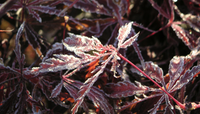
The mechanism of internal frost damage is not related to the mechanism of salt scaling. Ice causes damage by two mechanisms: (1) as the volume increases during freezing, pressure is generated in the pores, and if there are no air voids to take up the volume increase, then damage is inevitable; (2) at the same time, crystallization pressure is generated by the growth of ice crystals in small pores, and this causes damage (as in the case of salt crystallization) unless the suction created by ice in the voids offsets that pressure. The role of the air voids incorporated into concrete is to furnish sinks for water displaced during the volume increase as water turns to ice. If the pores of the concrete are nearly saturated and there are not enough air voids in the concrete, then damage during freezing from hydraulic pressure is inevitable. When water enters the voids, it freezes and then begins to suck water from the surrounding mesopores. This results in a net contraction of the concrete, which offsets the positive crystallization pressure exerted by ice growing in the mesopores.
Relevant papers:
“Freezing Gels”, G.W. Scherer, J. Non-Cryst. Solids 155 (1993) 1-25
“Mechanisms of Frost Damage”, G.W. Scherer and J.J. Valenza II, pp. 209-246 in Materials Science of Concrete, Vol. VII, eds. J. Skalny and F. Young (American Ceramic Society, 2005)
This paper was a feature article in JACerS
“Mechanism for Salt Scaling”, J. J. Valenza II and G.W. Scherer, J. Am. Ceram. Soc. J. Am. Ceram. Soc. 89 [4] 1161–1179 (2006)
“Kinetics of Ice Growth in Concrete”, Z. Sun, D. Kumpf, and G.W. Scherer, paper W4-07.1 in Proc. 12th Int. Cong. Cement Chemistry, eds. J.J. Beaudoin, J.M. Makar, L. Raki (National Research Council of Canada, Montreal, Canada, 2007) ISBN 978-0-660-19695-4
“Modeling damage from ice and salt”, G.W. Scherer, pp. 13-23 in Proc. Int. RILEM Symp. On Concrete Modelling (CONMOD ’08), eds. E. Schlangen and G. DeSchutter (RILEM, Bagneux, France, 2008) ISBN-13: 978-2-35158-060-8
“Kinetics of ice growth in cement and concrete”, Z. Sun and G.W. Scherer, pp. 183-190 in Int. RILEM Symp. On Concrete Modelling (CONMOD ’08), eds. E. Schlangen and G. DeSchutter (RILEM, Bagneux, France, 2008) ISBN-13: 978-2-35158-060-8
“Kinetics of ice growth in cement paste”, Z. Sun, O. Abellan & G.W. Scherer, in Proc. 8th Int. Conf. Creep, Shrinkage and Durability of Concrete and Concrete Structures (ConCreep8), Ise-Shima, Japan (2008) 951~956
“Effect of Air Voids on the Dilatation of Mortar During Freezing”, Z. Sun and G.W. Scherer, p. 896-901 in Poromechanics IV, Proc. Fourth Biot Conf. on Poromechanics, New York, 2009. eds. H.I. Ling, A. Smyth, R. Betti (DEStech Publications, Lancaster, PA, 2009)
“Pore size and shape in mortar by thermoporometry”, Z. Sun and G.W. Scherer, Cement Concr. Res. 40 (2010) 740–751
“Measurement and Simulation of Dendritic Growth of Ice in Cement Paste”, Z. Sun and G.W. Scherer, Cem. Concr. Res. 40 (2010) 1393–1402
“Poromechanics of Frost Damage”, G.W. Scherer, pp. 153-168 in Proc. Mechanics and Physics of Porous Solids, Champs-sur-Marne, April, 2011 (Ifsttar, Paris, 2011) ISBN 978-2-7208-2593-4
“Concrete/Ice abrasion mechanics”, S. Jacobsen, G.W. Scherer, and E.M. Schul-son, Cem. Concr. Res. 73 (2015) 79–95
“Freezing induced stresses in concrete-steel composite beams and effect of air voids”, S. Jacobsen and George W. Scherer, pp. 71-80 in Int. RILEM Conf. Materi-als, Systems and Structures in Civil Eng. on Frost Action in Concrete, Eds. Marianne Tange Hasholt, Katja Fridh and R. Doug Hooton (RILEM, Tech. Univ. Denmark, Lyngby, Denmark, 2016) ISBN: 978-2-35158-182-7